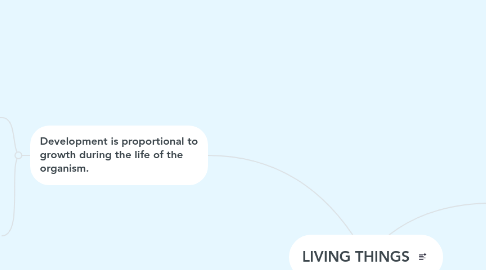
1. Development is proportional to growth during the life of the organism.
1.1. Every organism develops their own metabolic process, this is known as metabolism and every living thing have it to be alive.
1.1.1. A good homeostasis in the body depends on the homeostatic mechanism by regulating the cells number.
1.2. Homeostasis is when an organism mantains control in the body system.
2. Every organism react and respond to stimul
2.1. Every living thing move, breath, grow, reproduce, escrete, secrete, feed, etc. This are exapmles of stimul responding.
2.1.1. There are organism that respond qith speciffic cells, this means that every organ respond with different cells, like humans, plants, lizards, etc.
2.2. Respond to stimul also means to adaptation of environment.
2.2.1. This means that when organisms live in an environment, they need to have the ability to become essential in order to survive.
2.2.1.1. Survive is to continue with the race, that is whywe have the instict of reprodution, passing hereditary information to the next generations.
2.2.1.1.1. By the process of reproduction, we have passed though a process of genetic variation, and this is important for evolution, so organism can be better adapted for an environment.
2.2.2. All this pocess of adaptaion means evolution.
2.2.2.1. As humans, we have gone through a great and great process of evolution to be able to adapt to our environment.
3. Every living thing has a way to mantain in a avoltion progress.
3.1. This is known as DNA (Deoxyribonucleic acid). This is composed by sections, like 0-1-0-2-0-3
3.1.1. DNA is in every cell, this means that is in every part of our body.
3.1.1.1. Every cell has organelles, that make sugar (what we eat) into energy.
3.1.2. This sections are better known as CRISPR (Clustered Regularly Interspaced Short Palindromic Repeats)
3.1.2.1. So, we can say that this is an algorithm that body uses to mantain the hereditary information for next generations.
3.2. There is something known as CAS9. This erase the infected code from the DNA and replace it taking a copy of others.
4. Cells make life possible
4.1. Every cell can make tissues, tissues turn into organs, organs make a system, and all is made from atoms.
4.1.1. Cells can be divided into Prokaryotic and eukaryotic
4.1.1.1. Prokaryotic This cells don´t have citoplasm, this means that it don´t have a nucleus.
4.1.1.2. Eukariotic: This cells have many organelles and nucleus to keep DNA.
4.1.2. Every cell has citoplasm to keep organelles and create energy and having nucleus to keep the hereditary code.
